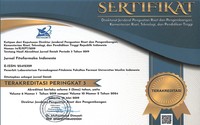Karakterisasi Senyawa Penghambat Polimerisasi Heme Dari Ekstrak Etanol Buah Pare (Momordica charantia L.)
Abstract
Keywords
Full Text:
PDF (Bahasa Indonesia)References
Abdillah, S., Tambunan, R.M., Sinaga, Y.M. and Farida, Y., 2014. Ethno-botanical survey of plants used in the traditional treatment of malaria in Sei Kepayang, Asahan of North Sumatera. Asian Pacific journal of tropical medicine, 7, pp.S104-S107.
Abu-Lafi, S., Akkawi, M., Al-Rimawi, F., Abu-Remeleh, Q. and Lutgen, P., 2020. Morin, quercetin, catechin and quercitrin as novel natural antimalarial candidates. Pharmacy & Pharmacology International Journal, 8(3), pp. 184–190.
Baelmans, R., Deharo, E., Muñoz, V., Sauvain, M. and Ginsburg, H., 2000. Experimental conditions for testing the inhibitory activity of chloroquine on the formation of β-hematin. Experimental Parasitology, 96(4), pp.243-248.
Haldar, K., Bhattacharjee, S. and Safeukui, I., 2018. Drug resistance in Plasmodium. Nature Reviews Microbiology, 16(3), pp.156-170.
Harborne, A.J., 1998. Phytochemical methods a guide to modern techniques of plant analysis. springer science & business media.
Herraiz, T., Guillén, H., González-Peña, D. and Arán, V.J., 2019. Antimalarial quinoline drugs inhibit β-hematin and increase free hemin catalyzing peroxidative reactions and inhibition of cysteine proteases. Scientific reports, 9(1), p.15398.
Huy, N.T., Maeda, A., Uyen, D.T., Trang, D.T., Sasai, M., Shiono, T., Oida, T., Harada, S. and Kamei, K., 2007. Alcohols induce beta-hematin formation via the dissociation of aggregated heme and reduction in interfacial tension of the solution. Acta Tropica, 101(2), pp.130-138.
Kementrian Kesehatan Republik Indonesia , 2020. Laporan Situasi Terkini Perkembangan Pengendalian Malaria di Indonesia Tahun 2019. pp. 1-19.
Liu, Y.J., Lai, Y.J., Wang, R., Lo, Y.C. and Chiu, C.H., 2020. The Effect of Thermal Processing on the Saponin Profiles of Momordica charantia L. Journal of Food Quality, 2020, p.1-7.
Pan, W.H., Xu, X.Y., Shi, N., Tsang, S.W. and Zhang, H.J., 2018. Antimalarial activity of plant metabolites. International Journal of Molecular Sciences, 19(5), p.1382.
Slamet, A. and Andarias, S.H., 2018. Studi Etnobotani dan Identifikasi Tumbuhan Berkhasiat ObatMasyarakat Sub Etnis Wolio Kota Baubau Sulawesi Tenggara. In Proceeding Biology Education Conference: Biology, Science, Enviromental, and Learning (Vol. 15, No. 1, pp. 721-732).
Susilawati, S. and Hermansyah, H., 2014. Uji Potensi Antiplasmodium Ekstrak Buah Pare (Momordica charantia L.) Terhadap Plasmodium falcifarum. Molekul, 9(1), pp.13-17.
Taek, M.M., Banilodu, L., Neonbasu, G., Watu, Y.V., EW, B.P. and Agil, M., 2019. Ethnomedicine of Tetun ethnic people in West Timor Indonesia: Philosophy and practice in the treatment of malaria. Integrative Medicine Research, 8(3), pp.139-144.
Taek, M.M., Bambang, P.E. and Agil, M., 2018. Plants used in traditional medicine for treatment of malaria by Tetun ethnic people in West Timor Indonesia. Asian Pacific Journal of Tropical Medicine, 11(11), pp.630-637.
World Health Organization, 2021. World Malaria Report 2021. www.who.int/teams/global-malaria-programme
DOI: https://doi.org/10.33096/jffi.v10i2.937
Copyright (c) 2023 Purwaning Nugroho Widiyati

This work is licensed under a Creative Commons Attribution-ShareAlike 4.0 International License.
Indexed by:
ISSN: 2356-0398 | e-ISSN: 2541-2329
Editor's Address:
Third Floor Pharmacognosy-phytochemistry laboratory building, Urip Sumoharjo road km. 5 Campus II UMI, Makassar, South Sulawesi, Indonesia
Phone: +6281524045514
Fax: +62411425619
E-mail: editorjfi@umi.ac.id

















.jpg)

